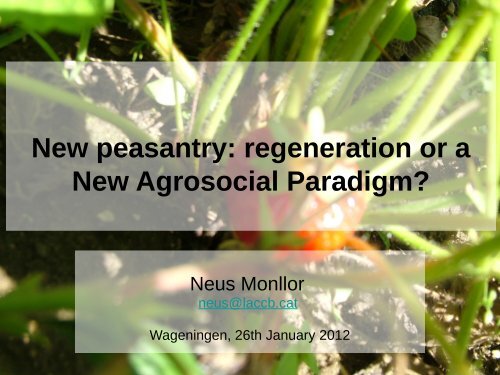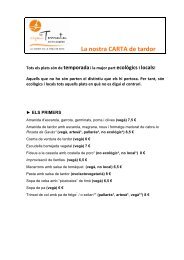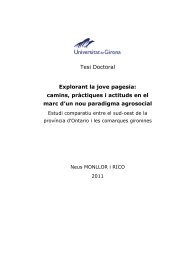New peasantry: regeneration or a New Agrosocial Paradigm?
New peasantry: regeneration or a New Agrosocial Paradigm?
New peasantry: regeneration or a New Agrosocial Paradigm?
Create successful ePaper yourself
Turn your PDF publications into a flip-book with our unique Google optimized e-Paper software.
<strong>New</strong> <strong>peasantry</strong>: <strong>regeneration</strong> <strong>or</strong> a<br />
<strong>New</strong> <strong>Agrosocial</strong> <strong>Paradigm</strong>?<br />
Neus Monll<strong>or</strong><br />
neus@laccb.cat<br />
Wageningen, 26th January 2012
How has it been done?<br />
Methodology
The study areas
Southern Ontario (Canada)
Girona area (Catalonia)
Southern Ontario<br />
Girona Area
Expl<strong>or</strong>at<strong>or</strong>y phase<br />
• Young farmer definition<br />
A person between 18 and 40 years old when he <strong>or</strong> she<br />
sets-up in farming<br />
• Confirmation of two different groups of young<br />
farmers to be studied<br />
Continuers / <strong>New</strong>comers<br />
• The creation of an Index to measure the<br />
practices and attitudes of young farmers<br />
Adaptation of the OECD idea
The <strong>New</strong> Rural <strong>Paradigm</strong> by OCDE (2006)<br />
Objectives<br />
Key target<br />
sect<strong>or</strong>s<br />
Old <strong>Paradigm</strong> <strong>New</strong> <strong>Paradigm</strong><br />
Equalization<br />
Farm income<br />
Competitiveness<br />
Agriculture<br />
Competitiveness of rural<br />
areas<br />
Val<strong>or</strong>ization of local assets<br />
Exploitation of unused<br />
resources<br />
Various sect<strong>or</strong>s of rural<br />
economies<br />
Main tools Subsidies Investments<br />
Key act<strong>or</strong>s<br />
National government,<br />
farmers<br />
All levels of government,<br />
various stakeholders<br />
Source: <strong>New</strong> Rural <strong>Paradigm</strong>: policies and programs (OCDE, 2006)
The <strong>New</strong> Rural <strong>Paradigm</strong> by Monll<strong>or</strong> (2008)<br />
LOCAL SCALE<br />
INNOVATION<br />
DIVERSITY<br />
ENVIRONMENT<br />
COOPERATION
The <strong>New</strong> Rural <strong>Paradigm</strong> by Monll<strong>or</strong> (2008)<br />
SLOW FOCUS<br />
SOCIAL<br />
COMMITMENT<br />
AUTONOMY<br />
LOCAL SCALE<br />
INNOVATION<br />
DIVERSITY<br />
ENVIRONMENT<br />
COOPERATION
COMPONENT<br />
PRACTICES:<br />
ELEMENT 1<br />
LOCAL SCALE Direct marketing<br />
DIVERSITY Diversity of the economic activity<br />
ENVIRONMENT<br />
Elements that define practices<br />
Environmental improvements in<br />
the farm<br />
COOPERATION Cooperation with other farmers<br />
INNOVATION Adoption of innovative practices<br />
AUTONOMY Feel trap f<strong>or</strong> something<br />
SOCIAL COMMITMENT Link to the association netw<strong>or</strong>k<br />
“SLOW” FOCUS Affectation of the rise price of oil<br />
PRACTICES:<br />
ELEMENT 2<br />
Local identification of the<br />
product<br />
Diversity of<br />
commercialization chains<br />
Organic production<br />
Cooperation with non<br />
agricultural act<strong>or</strong>s<br />
Redaction of a business<br />
plan<br />
Decide the price of the<br />
product<br />
To be an active member<br />
in a association<br />
Degree of investment in<br />
the starting point
COMPONENT<br />
Elements that define attitudes<br />
ACTITUD:<br />
ELEMENT 1<br />
LOCAL SCALE Local scale as a future strategy<br />
DIVERSITY<br />
ENVIRONMENT<br />
COOPERATION<br />
INNOVATION<br />
Public supp<strong>or</strong>t f<strong>or</strong> farms to<br />
diversify<br />
Public supp<strong>or</strong>t to promote<br />
environmental practices on<br />
farms<br />
Cooperation with nonagricultural<br />
associations<br />
Experimentation with new<br />
ideas<br />
AUTONOMY The control of the farm<br />
SOCIAL<br />
COMMITMENT<br />
“SLOW” FOCUS<br />
Generation of jobs in rural<br />
areas<br />
Intensification of production to<br />
take profits<br />
ACTITUD:<br />
ELEMENT 2<br />
Recovery of traditional<br />
varieties and breeds<br />
ACTITUD:<br />
ELEMENT 3<br />
Fashion buying and eating<br />
local products<br />
Multifunctionality of farming Diversity of farmers<br />
Modern agricultural<br />
practices take into account<br />
the environment<br />
Cooperation between<br />
farmers<br />
Innovation of farmers from<br />
its own resources<br />
Dependency of modern<br />
agricultural technology<br />
Use of GMOs<br />
Need to be big to be<br />
competitive<br />
Quality of food produced<br />
<strong>or</strong>ganically<br />
Cooperation between<br />
different agents to w<strong>or</strong>k on<br />
rural policy<br />
Imp<strong>or</strong>tance of technology<br />
to be competitive<br />
The role of municipalities<br />
in fostering farmers<br />
The involvement of<br />
farmers in maintaining<br />
rural areas<br />
Introduction of new<br />
agricultural practices<br />
gradually
Step 1<br />
EL_PRA1.1 + EL_PRA1.2 = EL_PRA<br />
D_PRA1.1 + D_PRA1.2 = D_PRA<br />
MA_PRA1.1 + MA_PRA1.2 = MA_PRA<br />
C_PRA1.1 + C_PRA1.2 = C_PRA<br />
I_PRA1.1 + I_PRA1.2 = I_PRA<br />
A_PRA1.1 + A_PRA1.2 = A_PRA<br />
CS_PRA1.1 + CS_PRA1.2 = CS_PRA<br />
AL_PRA1.1 + AL_PRA1.2 = AL_PRA<br />
Practice Index PRA<br />
Step 3<br />
Calculation of the Index<br />
Step 2<br />
EL_ACT1.1 + EL_ ACT 1.2 + EL_ACT1.3 = EL_ACT<br />
PRA + ACT = INDEX<br />
<strong>New</strong> <strong>Agrosocial</strong> <strong>Paradigm</strong><br />
Index<br />
D_ACT1.1 + D_ACT1.2 + D_ACT1.3 = D_ACT<br />
MA_ACT1.1 + MA_ACT1.2 + MA_ACT1.3 = MA_ACT<br />
C_ACT1.1 + C_ACT1.2 + C_ACT1.3 = C_ACT<br />
I_ACT1.1 + I_ACT1.2 + I_ACT1.3 = I_ACT<br />
A_ACT1.1 + A_ACT1.2 + A_ACT1.3 = A_ACT<br />
CS_ACT1.1 + CS_ACT1.2 + CS_ACT1.3 = CS_ACT<br />
AL_ACT1.1 + AL_ACT1.2 + AL_ACT1.3 = AL_ACT<br />
Attitude Index ACT<br />
INDEX
What are the most relevant results?<br />
Results
Continuers<br />
• Gender: man (85%)<br />
• Studies: college studies (63%)<br />
• Age at the Starting point: 21,9 years<br />
• Own a website: a min<strong>or</strong>ity (9%)<br />
• Business plan: a min<strong>or</strong>ity (15%)
<strong>New</strong>comers<br />
• Gender: woman (53%)<br />
• Studies: University (63%)<br />
• Age at the Starting point: 26,5 years<br />
• Own website: m<strong>or</strong>e than a half (63%)<br />
• Business plan: m<strong>or</strong>e than a half (56%)
Continuers<br />
• Start-up: own operat<strong>or</strong> <strong>or</strong> existing society<br />
• Sect<strong>or</strong>: the traditional of the area (milk and<br />
cattle)<br />
• Production: conventional<br />
• Access to land: set-up in a society, purchase o<br />
family inheritance<br />
• Farms: big and in property<br />
• W<strong>or</strong>k: family and wage<br />
• Capital: medium-big investments. Bank, savings<br />
and public aid<br />
• Investment: improvement <strong>or</strong> purchase of<br />
machinery, land <strong>or</strong> livestock<br />
• Commercialization: distribution companies
<strong>New</strong>comers<br />
• Start-up: own operat<strong>or</strong><br />
• Sect<strong>or</strong>: vegetables and sheep<br />
• Production: <strong>or</strong>ganic<br />
• Access to land: buying <strong>or</strong> renting,<br />
inf<strong>or</strong>mal agreements<br />
• Farms: smalls and lease<br />
• W<strong>or</strong>k: alone and pluriactive<br />
• Capital: small-medium<br />
investments. Bank and savings<br />
• Investment: basic infrastructure<br />
and purchase of machinery, land <strong>or</strong><br />
livestock<br />
• Commercialization: direct<br />
marketing
The pathway to become a farmer
Behavi<strong>or</strong> towards a <strong>New</strong> <strong>Paradigm</strong><br />
ESCALA LOCAL<br />
ALENTIMENT<br />
DIVERSITAT<br />
COMPROMÍS<br />
SOCIAL<br />
MEDI AMBIENT<br />
AUTONOMIA COOPERACIÓ<br />
INNOVACIÓ<br />
Step 3<br />
PRA + ACT = INDEX<br />
<strong>New</strong> <strong>Agrosocial</strong> <strong>Paradigm</strong><br />
Index<br />
INDEX
Behavi<strong>or</strong> towards a <strong>New</strong> <strong>Paradigm</strong>
Social Commitment<br />
Slow Focus<br />
Autonomy<br />
Young farmers practices<br />
Local Scale<br />
10<br />
9<br />
8<br />
7<br />
6<br />
5<br />
4<br />
3<br />
2<br />
1<br />
0<br />
I nnovation<br />
Continuers <strong>New</strong>comers<br />
Diversity<br />
Cooperation<br />
Environment
Social Commitment<br />
Slow Focus<br />
Autonomy<br />
Young farmers practices<br />
Local Scale<br />
10<br />
9<br />
8<br />
7<br />
6<br />
5<br />
4<br />
3<br />
2<br />
1<br />
0<br />
I nnovation<br />
Diversity<br />
Environment<br />
Cooperation<br />
Ontarian Continuers Ontarian <strong>New</strong>comers<br />
Catalan Continuers Catalan <strong>New</strong>comers
SLOW FOCUS<br />
SOCIAL<br />
COMMITMENT<br />
AUTONOMY<br />
LOCAL SCALE<br />
INNOVATION<br />
DIVERSITY<br />
ENVIRONMENT<br />
COOPERATION
Social Commitment<br />
Attitudes towards a new paradigm<br />
Slow Focus<br />
Autonomy<br />
Local Scale<br />
10<br />
9<br />
8<br />
7<br />
6<br />
5<br />
4<br />
3<br />
2<br />
1<br />
0<br />
I nnovation<br />
Continuers <strong>New</strong>comers<br />
Diversity<br />
Cooperation<br />
Environment
Social Commitment<br />
Attitudes towards a new paradigm<br />
Slow Focus<br />
Autonomy<br />
Local Scale<br />
10<br />
9<br />
8<br />
7<br />
6<br />
5<br />
4<br />
3<br />
2<br />
1<br />
0<br />
I nnovation<br />
Diversity<br />
Environment<br />
Cooperation<br />
Ontarian Continuers Ontarian <strong>New</strong>comers<br />
Catalan Continuers Catalan <strong>New</strong>comers
SLOW FOCUS<br />
SOCIAL<br />
COMMITMENT<br />
AUTONOMY<br />
LOCAL SCALE<br />
INNOVATION<br />
DIVERSITY<br />
ENVIRONMENT<br />
COOPERATION
The farmers who approach to a <strong>New</strong> <strong>Paradigm</strong><br />
<strong>New</strong> <strong>peasantry</strong><br />
Nuevo Campesinado Nova pagesia<br />
“Seeds of change towards a new paradigm”
NEW PEASANTRY Practices<br />
• Development of sh<strong>or</strong>t and direct marketing channels (96.8%).<br />
• Diversification of economic activity (90.3%) and the means to<br />
reach the consumer(78.1%).<br />
• Inc<strong>or</strong>p<strong>or</strong>ation of <strong>or</strong>ganic production (90.3%)<br />
and environmental improvements on the farm (74.2%).<br />
• Cooperation with other farmers to promote a new model<br />
of lab<strong>or</strong> and social relations (90.3%).<br />
• Inc<strong>or</strong>p<strong>or</strong>ation of innovative practices beyond<br />
the agricultural modernization (96.8%).<br />
• The 90.3% puts the price of the product sold.<br />
• Participation and involvement in social netw<strong>or</strong>ks (90.3%).<br />
• Less intensification of production and little dependence<br />
on fossil fuels (80.6%).
NEW PEASANTRY Attitudes<br />
• The future should focus m<strong>or</strong>e on the local level than<br />
in the global (96.8%).<br />
• It is imp<strong>or</strong>tant to diversify the resources of farming (90.3%).<br />
• The government should invest m<strong>or</strong>e resources in<br />
promoting environmentally friendly practices (90.3%).<br />
• There should be a stronger collab<strong>or</strong>ation among farmers (96.8%).<br />
• It is not necessary to keep up to date of the latest modern<br />
innovations (80.6%).<br />
• Eff<strong>or</strong>t to find strategies that allow them to be m<strong>or</strong>e independent and<br />
autonomous(96.8%).<br />
• Never to use a GMO’s (96.8%).<br />
• Not have to be big to be competitive (77.4%).
<strong>New</strong> <strong>peasantry</strong><br />
Beyond the rural...<br />
Nuevo Campesinado Nova pagesia<br />
• Improving communication: Internet and roads<br />
• Symbiosis between rural and urban areas<br />
• The agriculture has become strategic and essential<br />
• The value of social issues stands as an axial c<strong>or</strong>e
... From to the the <strong>New</strong> <strong>New</strong> <strong>Agrosocial</strong> Rural <strong>Paradigm</strong><br />
SLOW FOCUS<br />
SOCIAL<br />
COMMITMENT<br />
AUTONOMY<br />
LOCAL SCALE<br />
INNOVATION<br />
DIVERSITY<br />
ENVIRONMENT<br />
COOPERATION
Social Commitment<br />
Slow Focus<br />
Autonomy<br />
Opening attitudes of Continuers<br />
Local Scale<br />
10<br />
9<br />
8<br />
7<br />
6<br />
5<br />
4<br />
3<br />
2<br />
1<br />
0<br />
I nnovation<br />
Diversity<br />
Environment<br />
Cooperation<br />
Continuers practices <strong>New</strong>comers practices<br />
Continuers attitudes <strong>New</strong>comers attitudes
The latent empowerment of the XXI century <strong>peasantry</strong>
What are the c<strong>or</strong>e ideas?<br />
Contributions
What are the c<strong>or</strong>e ideas?<br />
Latent<br />
Peasantry<br />
<strong>Agrosocial</strong><br />
<strong>Paradigm</strong><br />
<strong>New</strong><br />
Peasantry
Let’s discuss all this issues!<br />
Bedankt!<br />
Thank you!





